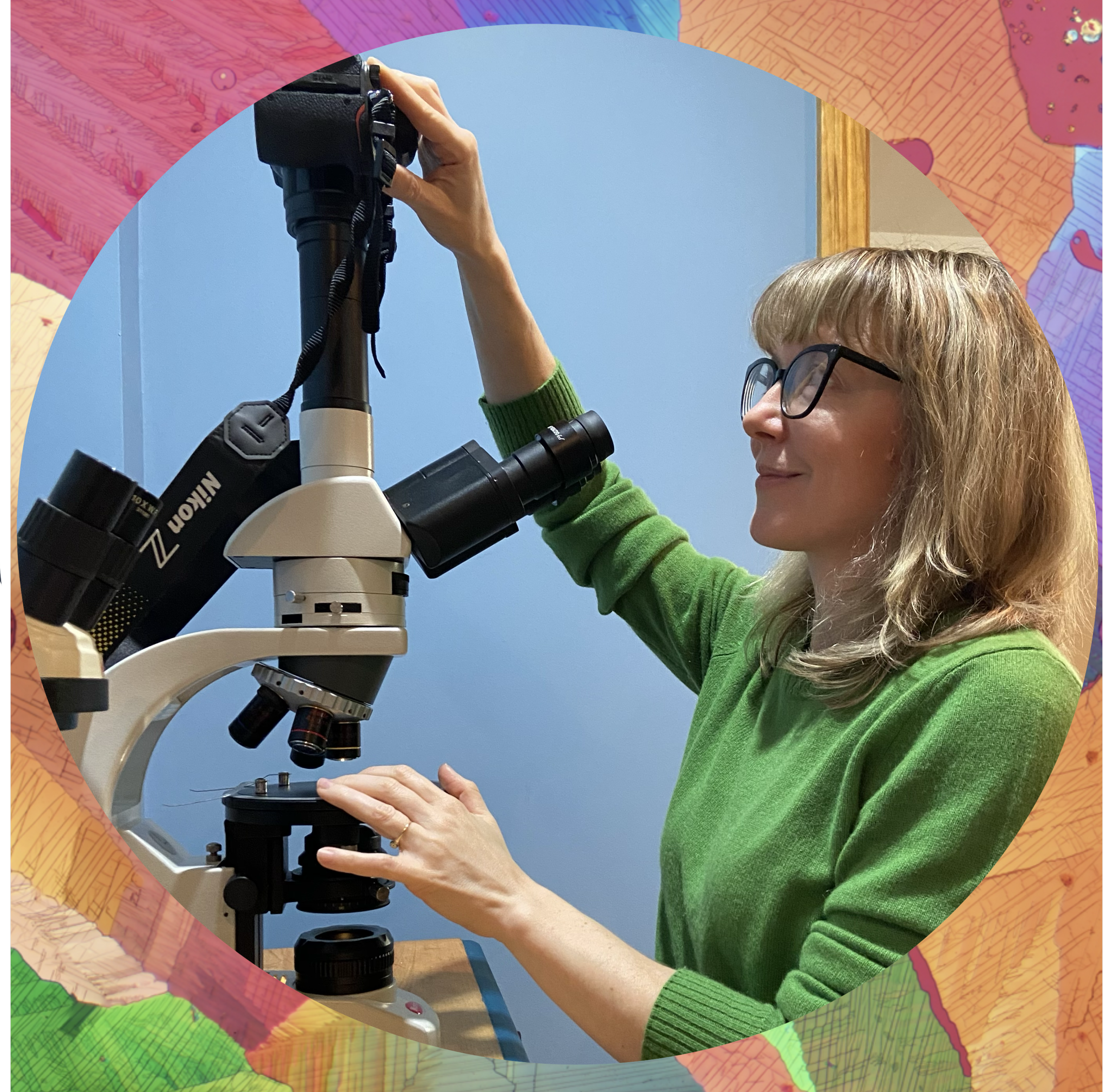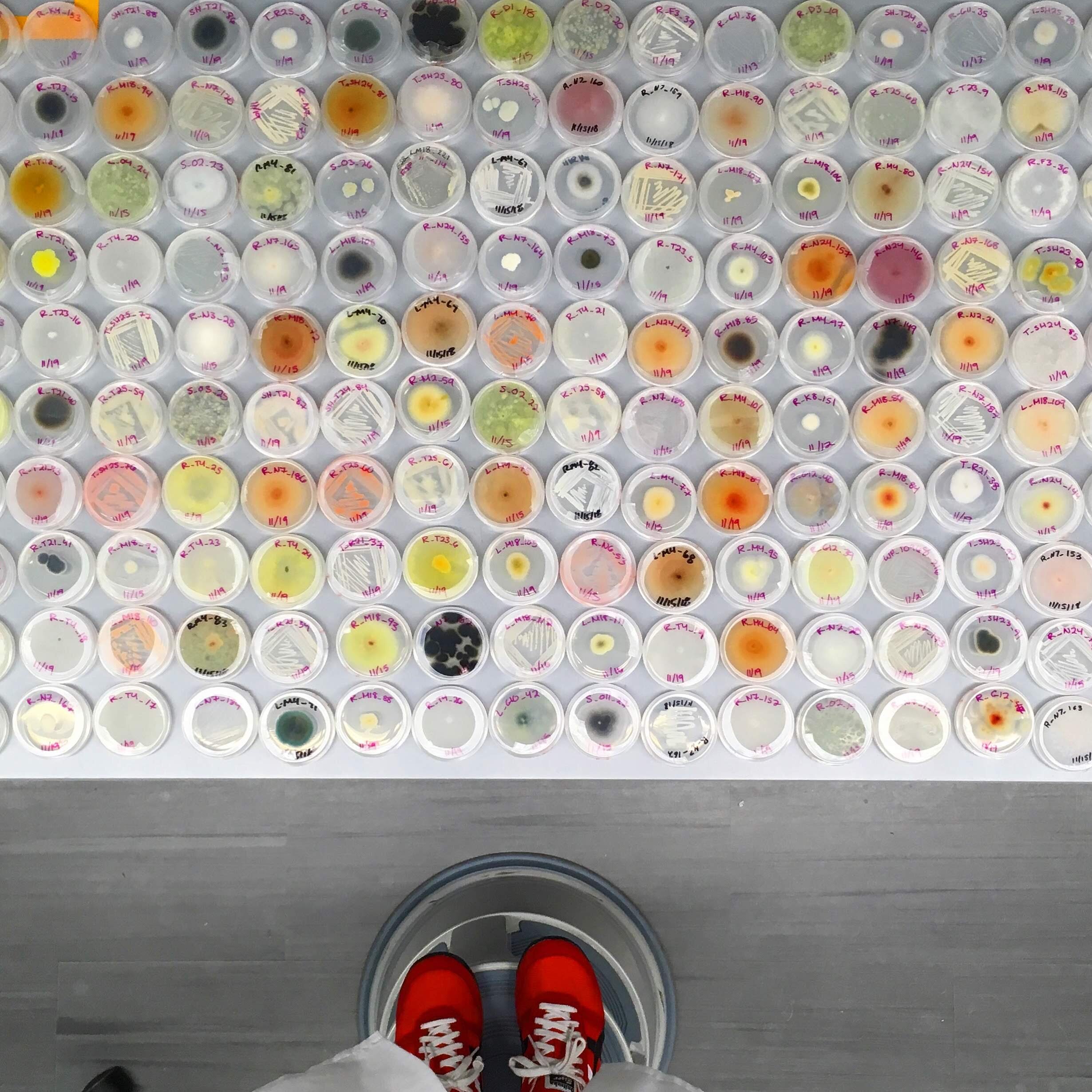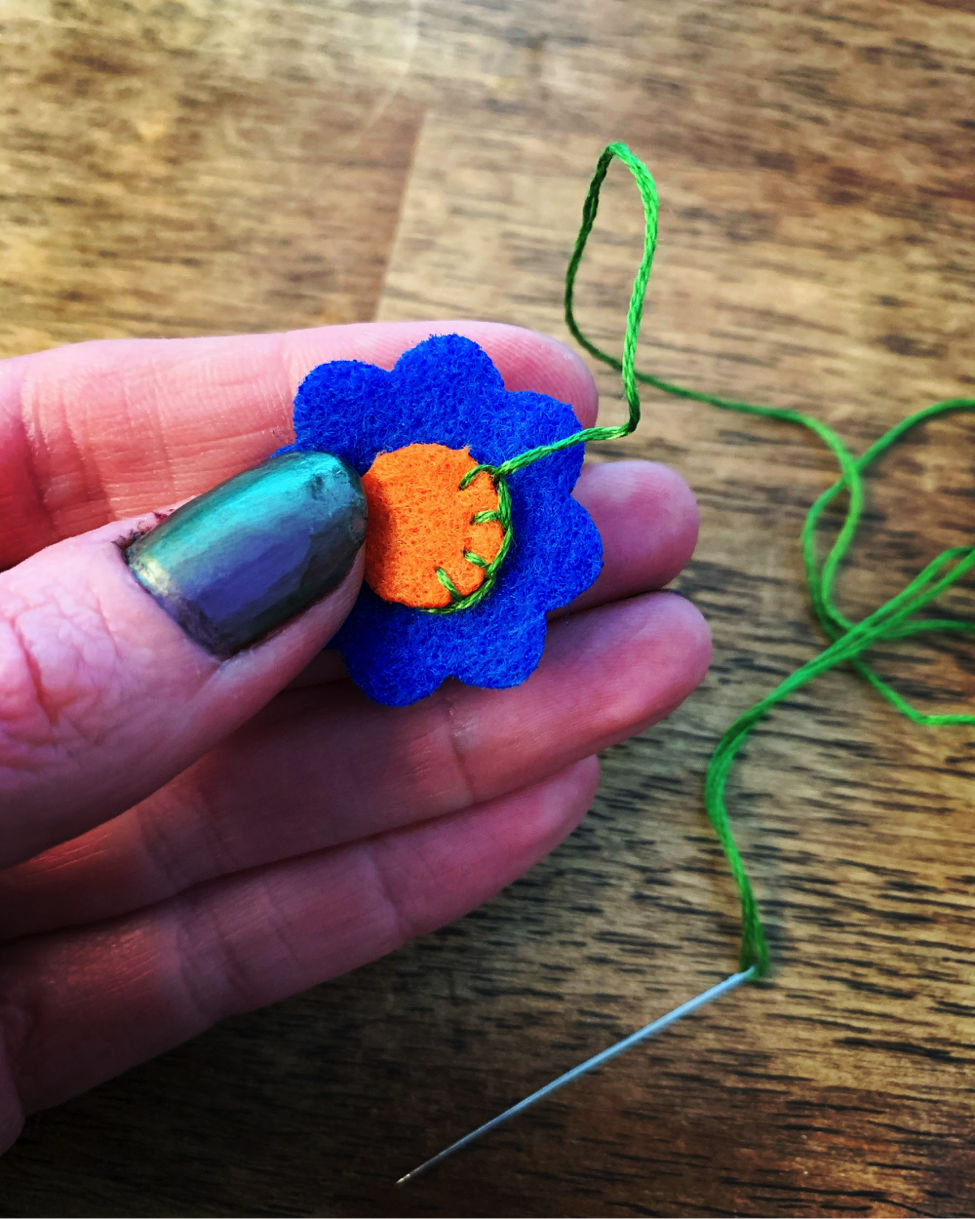
The Microbe Institute Fellows
Tracy Debenport is a research microbiologist who specializes in mycology (the study of fungi) and microbial art. Throughout her career, she has worked across academic and biotechnology labs. Her research has involved enhancing therapeutic proteins through glycoengineering, understanding the ecological role of Aspergillus flavus and aflatoxin production, and leveraging plant microbiomes to discover novel beneficial microbes for agricultural application.
In addition to being a published researcher, she is an award-winning photomicrographer. She has received multiple Nikon Small World Photomicrography awards and her images have appeared in magazines, blogs and books, such as The Explanatorium of Science. She manages a popular Instagram account that highlights the beauty of microbes through original photography and art. She has participated in a number of social media collaborations with such illustrious organizations as Cornell Fungi and Indigo Agriculture. Her art has also been displayed in galleries (Nikon Small World touring exhibit), at various science-art events at leading universities, and at science communication conferences (e.g., Harvard University’s Microbial Sciences Initiative Annual Symposium, and the Science Talk conference).
To learn more about this fellow visit her website, or her instagram account.
Examples of Tracy’s artistic work and research subjects
Plant Microbes (c) Tracy Debenport
Penicillium vulpinum (c) Tracy Debenport
“Microbial Sunrise” (c) Tracy Debenport
“Soil Microbes Plate” (c) Tracy Debenport
“Beta Alanine Crystals” (c) Tracy Debenport
“Aspergillus textile” (c) Tracy Debenport
“Aspergillus Colony” (c) Tracy Debenport
“My Work Bench” (c) Tracy Debenport
Fellow: Tracy Debenport
“Made with Microbes”
“Micro Love” (c) Tracy Debenport
The Project: Made with Microbes
The goal of this project, entitled “Made with Microbes,” is to create an art and activity book that highlights some of the microbes used in industry, medicine and food production-- from those that create the intoxicating alcohol in wine, to those which heroically produce life-saving antibiotics. Imbued with the playful whimsy of Tracy’s Keith Haring-esque graphic style, this exhibit will ask the audience to interrogate their relationship with microbes; highlighting how specific compounds mediate these interactions in impactful, if often invisible ways.
Project media: Graphic design, photography. Open-access component: An art and activity book leveraging these images and corresponding information to help achieve microbial application learning outcomes.
Project themes: Microbial education & Microbial art
PDF & Flipbook
Project References
https://my.clevelandclinic.org/health/treatments/penicillin
https://hms.harvard.edu/news/dynamite-bacteria
https://www.smithsonianmag.com/smart-news/smell-rain-explained-180974692/
https://www.hopkinsmedicine.org/health/wellness-and-prevention/how-statin-drugs-protect-the-heart
https://www.cdc.gov/plague/resources/recommended-antibiotics-for-plague-web-site-rev-jan2018-p.pdf
https://www.mayoclinic.org/drugs-supplements/erythromycin-oral-route/description
Bushley KE, Raja R, Jaiswal P, Cumbie JS, Nonogaki M, Boyd AE, Owensby CA, Knaus BJ, Elser J, Miller D, Di Y, McPhail KL, Spatafora JW. The genome of tolypocladium inflatum: evolution, organization, and expression of the cyclosporin biosynthetic gene cluster. PLoS Genet. Epub 2013 Jun 20.
Cairns, T.C., Nai, C. & Meyer, V. How a fungus shapes biotechnology: 100 years of Aspergillus niger research. Fungal Biol Biotechnol 5, 13 (2018).
Daba, G.M., Mostafa, F.A. & Elkhateeb, W.A. The ancient koji mold (Aspergillus oryzae) as a modern biotechnological tool. Bioresour. Bioprocess. 8, 52 (2021).
Da Conceicao Neta, E.R., Johanningsmeier, S.D. and McFeeters, R.F. The Chemistry and Physiology of Sour Taste—A Review. Journal of Food Science, 2007.
Fierro F, Vaca I, Castillo NI, García-Rico RO, Chávez R. Penicillium chrysogenum, a Vintage Model with a Cutting-Edge Profile in Biotechnology. Microorganisms. 2022 Mar 6.
Graber EM. Treating acne with the tetracycline class of antibiotics: A review. Dermatological Reviews. 2021.
Gerber NN, Lechevalier HA. Geosmin, an earthly-smelling substance isolated from actinomycetes. Appl Microbiol. 1965 Nov.
Junqi Wang, Meijie Liu, Meijie Liu, Chengzhi Mao, Chengzhi Mao, Sizhu Li, Jiabao Zhou, Yaqin Fan, Lizhong Guo, Hao Yu, Xiuqing Yang. Comparative proteomics reveals the mechanism of cyclosporine production and mycelial growth in Tolypocladium inflatum affected by different carbon sources. Front. Microbiol., 07 December 2023. Sec. Microbial Physiology and Metabolism Volume 14
Khan MS, Gao J, Munir I, Zhang M, Liu Y, Moe TS, Xue J, Zhang X. Characterization of Endophytic Fungi, Acremonium sp., from Lilium davidii and Analysis of Its Antifungal and Plant Growth-Promoting Effects. Biomed Res Int. 2021 Aug 3
Liu L, Chen Z, Liu W, Ke X, Tian X, Chu J. Cephalosporin C biosynthesis and fermentation in Acremonium chrysogenum. Appl Microbiol Biotechnol. 2022 Oct
Liu L, Peng S, Song W, Zhao H, Li H, Wang H. Genomic Analysis of an Excellent Wine-Making Strain Oenococcus oeni SD-2a. Pol J Microbiol. 2022 Jun 19
Mohammad Rifqi Ghiffary, Cindy Pricilia Surya Prabowo, Komal Sharma, Yuchun Yan, Sang Yup Lee, and Hyun Uk Kim. High-Level Production of the Natural Blue Pigment Indigoidine from Metabolically Engineered Corynebacterium glutamicum for Sustainable Fabric Dyes. ACS Sustainable Chemistry & Engineering 2021 9
Morowitz MJ, Carlisle EM, Alverdy JC. Contributions of intestinal bacteria to nutrition and metabolism in the critically ill. Surg Clin North Am. 2011 Aug
Nielsen JC, Richelieu M.1999.Control of Flavor Development in Wine during and after Malolactic Fermentation by Oenococcus oeni. Appl Environ Microbiol65
Oliynyk, M., Samborskyy, M., Lester, J. et al. Complete genome sequence of the erythromycin-producing bacterium Saccharopolyspora erythraea NRRL23338. Nat Biotechnol 25, 447–453 (2007).
Parapouli M, Vasileiadis A, Afendra AS, Hatziloukas E. Saccharomyces cerevisiae and its industrial applications. AIMS Microbiol. 2020 Feb 11
Peter Hirsch, Udo Mevs, Reiner M. Kroppenstedt, Peter Schumann, Erko Stackebrandt. Cryptoendolithic Actinomycetes from Antarctic Sandstone Rock Samples: Micromonospora endolithica sp. nov. and two Isolates Related to Micromonospora coerulea Jensen 1932. Systematic and Applied Microbiology, Volume 27, Issue 2, 2004
Qian, M., Nelson, C. & Bloomer, S. Evaluation of fat-derived aroma compounds in blue cheese by dynamic headspace GC/Olfactometry-MS. J Amer Oil Chem Soc 79, 663–667 (2002).
Ramachanderan, R., Schaefer, B. Tetracycline antibiotics. ChemTexts, 18 (2021).
Román-Camacho JJ, García-García I, Santos-Dueñas IM, García-Martínez T, Mauricio JC. Latest Trends in Industrial Vinegar Production and the Role of Acetic Acid Bacteria: Classification, Metabolism, and Applications-A Comprehensive Review. Foods. 2023 Oct 9
Ruchala J, Kurylenko OO, Dmytruk KV, Sibirny AA. Construction of advanced producers of first- and second-generation ethanol in Saccharomyces cerevisiae and selected species of non-conventional yeasts (Scheffersomyces stipitis, Ogataea polymorpha). J Ind Microbiol Biotechnol. 2020 Jan;
Satoshi Ōmura. A Splendid Gift from the Earth: The Origins and Impact of the Avermectins Nobel Lecture, December 7, 2015. Kitasato University, Tokyo, Japan
Sebastian J, Dominguez KV, Brar SK, Rouissi T. Fumaric acid production using alternate fermentation mode by immobilized Rhizopus oryzae-a greener production strategy. Chemosphere. 2021 Oct;28
Sheng Q, Wu XY, Xu X, Tan X, Li Z, Zhang B. Production of l-glutamate family amino acids in Corynebacterium glutamicum: Physiological mechanism, genetic modulation, and prospects. Synth Syst Biotechnol. 2021 Sep 20
Tao, H., Zhang, Y., Deng, Z. and Liu, T. (2019), Strategies for Enhancing the Yield of the Potent Insecticide Spinosad in Actinomycetes. Biotechnol. J., 14: 1700769.
Walker GM, Stewart GG. Saccharomyces cerevisiae in the Production of Fermented Beverages. Beverages. 2016
Wang B-T, Hu S, Yu X-Y, Jin L, Zhu Y-J, Jin F-J. Studies of Cellulose and Starch Utilization and the Regulatory Mechanisms of Related Enzymes in Fungi. Polymers. 2020
Wang Yanyan, Liu Linxia, Jin Zhaoxia, Zhang Dawei. Microbial Cell Factories for Green Production of Vitamins. Frontiers in Bioengineering and Biotechnology Vol 9, 2021
Wei Z, Shi X, Lian R, Wang W, Hong W, Guo S. Exclusive Production of Gentamicin C1a from Micromonospora purpurea by Metabolic Engineering. Antibiotics (Basel). 2019 Dec 14
Zhgun AA, Nuraeva GK, Volkov IA. High-Yielding Lovastatin Producer Aspergillus terreus Shows Increased Resistance to Inhibitors of Polyamine Biosynthesis. Applied Sciences. 2020
Zhang Q, Lyu S. Microbial Interactions in a Vitamin C Industrial Fermentation System: Novel Insights and Perspectives. Appl Environ Microbiol. 2022 Sep 22
Cephalosporins: A group of antibiotics that originate from the fungus Acremonium.
Penicillin G: The classic antibiotic derived from the fungus Penicillium.
Fellow: Kristina Skillin
“Sew Curious”
Kristina Skillin, M.Sc. is an artist, archeologist, and historian who traces the human narrative to connect historical practices to the development of technologies and products throughout history. As a professionally trained artist and scientist, she engages diverse audiences through the creation of art and adornment, microscopy-based research, and by creating projects that reveal the connection and interconnection of people through the common practice of ornamentation and design.
Her research interests include Arctic Archaeology, prehistoric human/animal relations, geoarchaeology (soil sciences), the development of metalsmithing technologies, the development of clothing and adornment, and historic and prehistoric ornamentation. She holds two B.A.s in Metals and Jewelry, and Classical Languages, as well as a M.Sc. from the University of Aberdeen in Archaeology where her dissertation Splitting Hairs: Testing the Feasibility of Light Microscopy Use on the Identification of Archaeological Cold-Preserved Fur and Hair included the development of a new process for speciating fur and hair remains.
Currently, she is the Co-founder and Director at the Museum of Beadwork where she is leading an international community project aimed at recording the passing of the Covid-19 pandemic and its effects on artistic communities and the individual’s experience.
To learn more about this fellow, visit her website & shop, her instagram account, or the Museum of Beadwork.
Examples of Kristina’s work and research subjects
A hair sample under a microscope
Stitching for the Sew Frazzled sewing workshop
Kristina investigating a site
The Project: Sew Curious
The goal of this project is to communicate the relevance of microbes through fashion, using photomicroscopy images of microbes to create utilitarian fashion accessories.
The microbes in focus are those we interact with frequently, or those that have a common occurrence in everyday life, yet those we are unaware of. The inaugural image is that of a yeast related to those used in bread baking and beer making. Two timely topics in this pandemic era. The material is printed at a US based company located in New England, then crafted by the artist and her company in Maine.
The microbe featured on these bags is a species of Saccharomyces yeast. These yeasts are a group of fungi, and include the yeast species we know as “baking yeast” and “brewing yeast.” These single-celled organisms are microscopic and replicate by cloning themselves. In bread, they feed on the sugars and flour and produce alcohols (that evaporate in the oven), some of the flavors, and carbon dioxide. This carbon dioxide produces the bubbles that leaven the bread, creating a rise. In beer, these yeasts are producing some of the carbon dioxide, all of the alcohol, and up to 50% of the flavor in each sip. Ever since we have been making bread or beer (many thousands of years ago) we have been relying on species of yeast to help us transform grains and water into the nutritive, intoxicating foods we enjoy. Other foods and beverages made possible by yeast include chocolate, wine, donuts, scotch, pretzels, and anything that lists “yeast lysate” or “nutritive yeast” or “yeast flakes” in their ingredients.
These Scanning Electron Micrograph images were originally created, arranged, and false-colored by collaborators at Mississippi State University.
Project media: Cloth, fashion accessories, photomicroscopy. Open-access component: TBD
Project themes: Microbial art & Science communication
To visit the full project, visit the Etsy Shop
Project Preview
Fellow: Sam Ruk
“Interbiota”
Sam Ruk (she/her) is a high school senior based in California, USA. Digital art is her first interest–she is always looking to explore ideas through creative illustration or colorful design. Biology is her second interest–she hopes to pursue academic research in one of the many disciplines she is curious about.
To learn more about this fellow, visit her project website.
The Project: Interbiota
Interbiota is an educational website with the intention of broadening the audience’s view of the microbial world. Microbiology is full of stories with fascinating microbial characters–microbes that light up the ocean, conduct trade deals with plants, make homes in our belly button, and much more. Through colorful design, playful illustrations, and accessible language, Interbiota aims to showcase these microbial stories in an engaging way.
In the words of the creator, Sam, “I created Interbiota to learn about microbiology, having known little about the field myself. Through the process of reading, synthesizing, and communicating research, I learned so much more than I would have ever expected. Interbiota reflects my perspective as a newcomer to microbiology: I tried to use language with enough clarity and accessibility that even I, a high school student, could understand the content. My hope is for anyone to be able to learn as much from my website as I learned by creating it.”
Project media: Digital. Open-access component: Publically-accessible website
Project themes: Microbial art, education & science communication
To visit the full project, visit the Interbiota.
Project Preview
Support the Projects of Fellows and Collaborators
These science art (or SciArt) projects are co-created between members of the Microbe Institute and interdisciplinary artists, scientists, and educators. Learn more about the fellows (and their projects) below, as well as the projects of some of our collaborators.
Sew Curious: Locally made canvas accessory bags printed with microscopic images of yeast cells. Featuring the work of Fellow Kristina Skillin.
Microbes & Molecules (NOT CURRENTLY ACTIVE): Fashion, bags, and diverse accessories featuring graphic artwork of microbes and the helpful molecules they create. Featuring the work of Fellow Tracy Debenport.
Microbially Speaking: 3D printed microbe earrings featuring helpful viruses that secretly make our world better. Featuring the work of Collaborator Lea Shell.
Interbiota: An educational website with the intention of broadening the audience’s view of the microbial world, created by Sam Ruk.
The Microbiology Dress: A SheNova dress featuring false-colored photomicrographs of Saccharomyces yeast cells. Featuring the work of Collaborator Holly Renee.

“Never neglect an extraordinary appearance or happening”
Alexander Fleming, discoverer of Penicillin

































